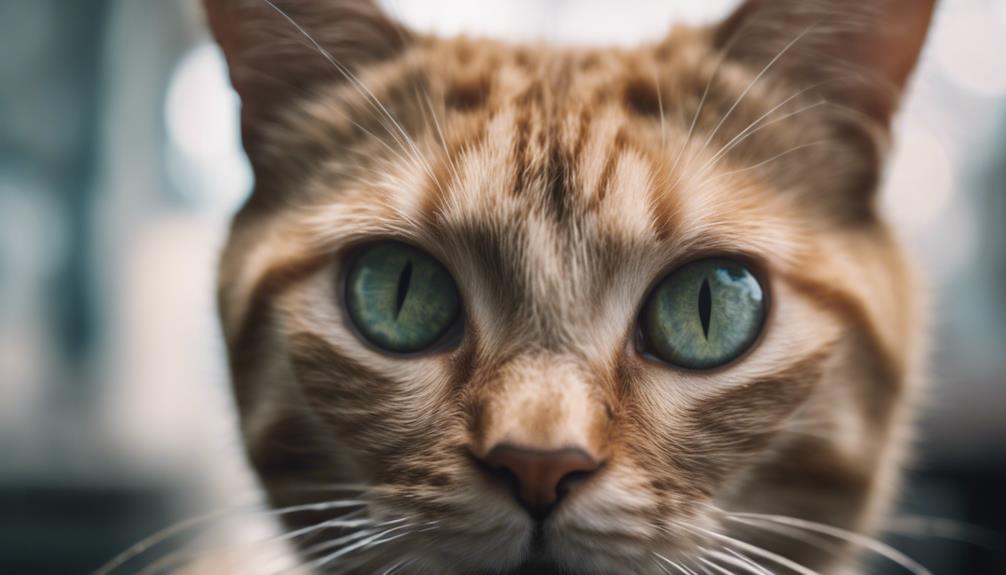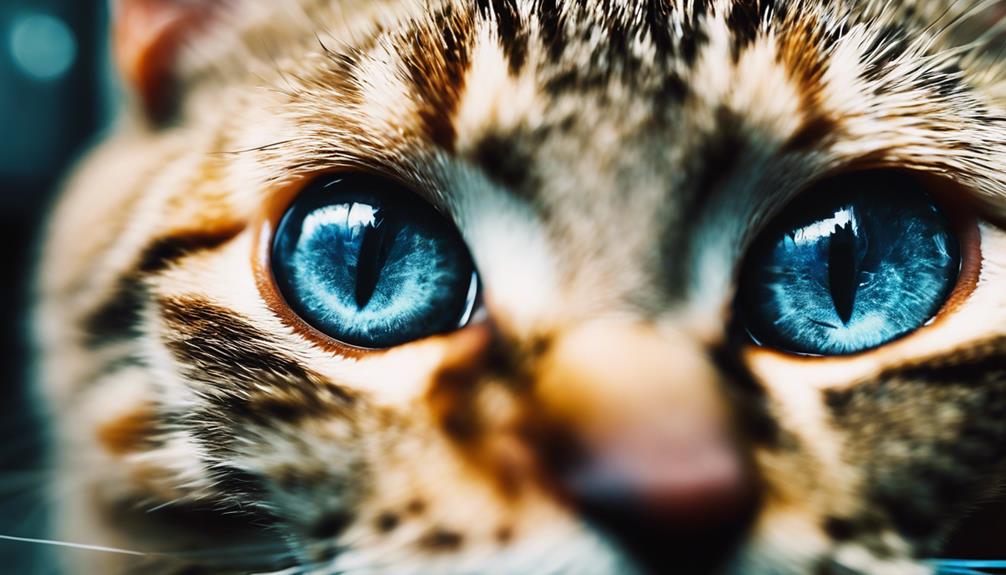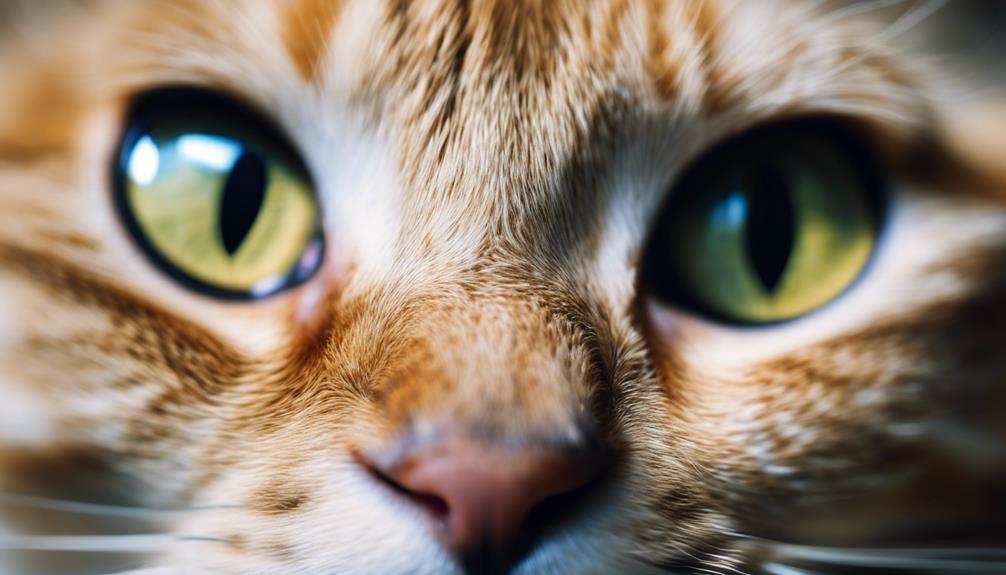Understanding cat pupil language is important for deciphering your feline friend's feelings. Cat pupils adjust based on light and reflect emotions. Dilated pupils show excitement or fear, while constricted ones signal contentment or stress. Pupil size mirrors emotional states, affected by surroundings and feelings. Eye expressions like affection or fear are revealed through shapes and movements. Eye movements swiftly convey moods and comfort levels. Nonverbal cues—like slow blinking—build trust and emotional bonds. Observing these cues enhances the connection with your cat. Explore this guide to uncover deeper insights into your cat's unspoken language.
Key Takeaways
- Cat pupils reflect emotional states and environmental stimuli.
- Pupil size changes communicate shifts in mood and comfort levels.
- Dilated pupils indicate heightened emotions or responses.
- Constricted pupils suggest fear, discomfort, or stress.
- Understanding context is crucial for accurate interpretation of cat pupil language.
Cat Pupil Language Basics
Cat pupils constantly adjust in size to effectively respond to varying light conditions, reflecting the cat's emotional state and environment.
When cats are excited or experiencing fear, their pupils dilate, allowing more light in to enhance visual acuity and prepare for action.
On the contrary, constricted pupils in cats signal relaxation, contentment, or exposure to bright lighting environments.
These changes in pupil size serve as an essential mechanism for cats to adapt to different lighting conditions efficiently.
By monitoring the dilation and constriction of cat pupils, one can gain valuable insights into the feline's emotional state and surroundings.
Understanding these basic principles of cat pupil language provides a window into the world of our feline companions, allowing us to interpret their feelings and reactions more accurately.
Mastering the art of deciphering cat pupil language enhances our ability to comprehend and communicate with these fascinating creatures on a deeper level.
Interpreting Dilated Pupils

In situations where a feline's pupils dilate, it indicates heightened emotions or responses to stimuli. Dilated pupils in cats can be a sign of excitement, fear, or arousal triggered by various stimuli in their environment.
The enlargement of the pupils allows more light to enter the eyes, improving visual acuity, especially in low light conditions. This physiological response is controlled by the autonomic nervous system, reflecting the cat's emotional state and level of alertness.
Understanding the context in which a cat's pupils dilate is vital for interpreting their feelings and reactions accurately. Cats may exhibit dilated pupils during moments of play, hunting, or when they feel threatened, showcasing the dynamic nature of their responses to different situations.
Deciphering Constricted Pupils

Deciphering the meaning behind a cat's constricted pupils provides valuable insights into their emotional state and current level of alertness. When a cat's pupils are constricted, it can indicate feelings of fear, discomfort, or stress. Changes in light conditions often lead to pupils constricting as a way for cats to protect their sensitive eyes.
Additionally, constricted pupils may signal aggression or a defensive posture in cats. Cats with constricted pupils tend to be more vital and on guard, ready to react to any potential threats. Understanding the significance of constricted pupils in cats is essential for accurately interpreting their emotional state.
Pupil Size and Emotional States

Exploring how pupil size in felines reflects their emotional states reveals valuable insights into their well-being and reactions to stimuli. Cat behavior often manifests through their eyes, with dilated pupils indicating heightened arousal levels and potential excitement in low light conditions.
Conversely, constricted pupils in cats suggest relaxation, contentment, or even aggression in specific contexts. The ability of cat eyes to undergo rapid changes in pupil size enables them to communicate emotional shifts, such as fear transforming into curiosity or aggression escalating. These variations in pupil size are influenced by environmental factors, emotions, and overall arousal levels, providing observers with a window into the cat's emotional state.
Understanding Feline Eye Expressions

Observing a cat's eyes reveals a wealth of information about their current emotional state and intentions. Cat eye expressions can convey a range of emotions like affection, trust, aggression, fear, and alertness.
Pupil dilation in cats can indicate excitement, fear, lower light conditions, or heightened arousal. Different eye shapes and movements, along with body language cues such as wide eyes, slow blinking, ears forward, or an arched back, provide insights into a cat's mood.
Specific behaviors like slow blinking, half-closed eyes, staring, dilated pupils, or narrowed slits convey varying meanings. Understanding cat pupil language is essential for interpreting their emotions and responses accurately.
Decoding feline eye expressions involves paying attention to cat body language, cat eye narrowing movements, and the overall context of the situation. By observing these visual cues, one can gain a deeper understanding of a cat's feelings and intentions. For instance, slow eye blinks combined with a relaxed body posture often indicate trust and affection. In contrast, wide, unblinking eyes accompanied by a tense body could signal fear or heightened alertness. Understanding these subtle signals, much like interpreting ‘como in Spanish meaning “how” or “like”,’ can enhance communication between humans and their feline companions.
Significance of Eye Movements

Cats communicate a wealth of information through their eye movements, particularly their pupil dilation, which serves as a key indicator of their emotional state and level of arousal. Cat eyes dilate in response to various stimuli like excitement, fear, or changes in light, reflecting their current mood.
Pupil size changes rapidly in cats, adapting to different lighting conditions and emotional situations. By studying cat eye movements, we can gain insights into their mood, level of alertness, and comfort levels. Understanding these aspects of cat body language is vital for interpreting their feelings and enhancing communication with our feline companions.
Paying attention to their eye movements can help us decipher what our cats are trying to convey, whether they're feeling playful, scared, or content. Mastering the art of reading cat eye movements is essential for building a strong bond with our furry friends.
Cat Pupil Language in Bonding

Bonding with cats involves deciphering their subtle pupil language cues, including the slow blink that signifies trust and affection. Cats use slow blinking as a form of communication to express their feelings of security and connection with their owners.
Reciprocating this slow blink can strengthen the emotional bond and mutual understanding between the cat and its human. It's essential to understand that slow blinking is a non-threatening behavior that fosters a sense of trust and affection in the cat-human relationship.
Strengthening Cat-Human Connection

Understanding cat pupil language can play a vital role in building trust and deepening the emotional bond between cats and humans.
By reciprocating slow blinks and engaging in respectful eye contact, we can communicate love, trust, and understanding to our feline companions.
These positive interactions not only strengthen the cat-human connection but also enhance the overall quality of our relationships with our beloved pets.
Building Trust Through Communication
Strengthening the connection between humans and cats can be achieved by establishing trust through intentional communication methods, such as eye contact and slow blinking. When seeking to build trust with your feline companion, consider the following:
- Reciprocate slow blinking to show understanding and foster trust and affection.
- Respect your cat's boundaries and respond to their body language cues for effective communication.
- Consistent positive interactions, patience, and understanding of your cat's eye expressions help in developing trust over time.
- Trust forms the foundation for a healthy and fulfilling relationship between cats and their human companions.
Enhancing Emotional Bond
Enhancing the emotional connection with your cat involves actively engaging in nonverbal communication cues such as slow blinking and maintaining eye contact. By reciprocating a slow blink gesture, you can show your cat trust and affection, strengthening the bond between you. Understanding your cat's pupil size changes can provide insights into their emotional state, further deepening your emotional connection. Creating a calm and positive environment is key to fostering a strong emotional bond with your cat. Making eye contact with your cat can enhance the emotional connection between you, leading to a more profound relationship. As a cat parent, these simple yet powerful gestures can help build a trusting and loving bond with your feline companion.
| Nonverbal Communication Cues | Importance |
|---|---|
| Slow blinking | Conveys trust and affection |
| Maintaining eye contact | Enhances emotional connection |
| Pupil size changes | Insights into emotional state |
| Calm and positive environment | Fosters strong emotional bond |
Frequently Asked Questions
How Do You Decode Cat Language?
When decoding cat language, pay attention to their pupils. Dilated pupils indicate excitement or fear, while constricted ones signal relaxation or contentment. Rapid changes in pupil size can reveal emotional shifts.
Understanding these cues, along with other body language signs, helps decipher a cat's mood and intentions. Cat pupil language is vital in understanding feline communication and emotions.
What Do the Pupils of Cats Mean?
When we gaze into a cat's eyes, their pupils act as tiny storytellers, conveying a myriad of emotions. Dilated pupils reveal their heightened alertness or excitement, while constricted ones signal relaxation and contentment. Rapid changes in size hint at underlying feelings like fear or aggression.
Unequal pupils, known as anisocoria, could indicate health concerns needing vet attention. By observing these subtle cues alongside body language, we gain valuable insights into our feline friends' well-being.
What Does My Cats Body Language Mean?
When a cat communicates through body language, it conveys emotions and needs. An upright tail shows confidence, while a puffed-up tail signals fear. Forward-facing ears indicate relaxation, while flat ears may mean fear or aggression. Understanding these cues helps interpret a cat's mood and reactions.
Rapid tail twitching, flattened ears, or dilated pupils can indicate excitement, discomfort, or alertness. Interpreting these signals enhances our bond with feline companions.
How Do You Read a Cat's Pupils?
When reading a cat's pupils, notice dilated ones indicating excitement or fear, and constricted ones showing relaxation. Rapid changes signal alertness. These variations reveal the cat's emotional state.
Understanding this language helps interpret mood and engagement levels.
Conclusion
To sum up, deciphering cat pupil language provides valuable insights into our feline companions' emotions and intentions. By grasping the meaning behind dilated and constricted pupils, as well as the significance of eye movements, we can strengthen our bond with our cats and enhance our communication with them.
Paying attention to their eyes can help us connect on a deeper level and establish a harmonious relationship with our beloved pets. So next time you look into your cat's eyes, remember, there's a whole language waiting to be understood.










